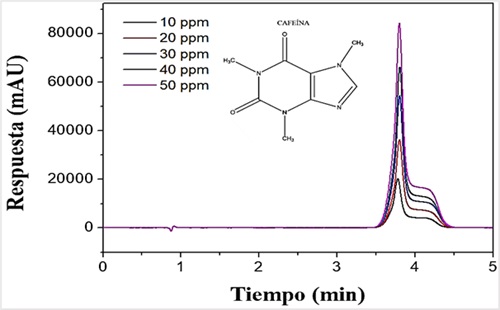Validation of a methodology for the caffeine quantification by liquid chromatography (UHPLC/DAD)
DOI:
https://doi.org/10.56926/repia.v3i1.56Keywords:
Amazon, coffee, caffeine, methodology, UHPLC-DADAbstract
The determination of caffeine in eight coffee samples from different cities of the Peruvian Amazon, Colombia, and Ecuador was carried out developing a methodology for the routine analysis of caffeine content in different samples by reversed-phase high-performance liquid chromatography. This study used a mobile phase of water: methanol (75:25, v/v), at a flow rate of 0.3 mL min-1 and a temperature of 45 °C. Caffeine was isocratically separated at 3.8 min. The caffeine concentrations in the samples were determined by a calibration curve with external standards, which were found to be in the range of 9.74 to 11.12 mg g-1 in roasted ground coffee, at 11.08 mg/g in coffee husk and from 9.17 to 26.59 mg/g in freeze-dried soluble coffee. 68.34, 93.98, and 78.0 % were recovered for the 50, 100, and 150 μg mL-1 fortifications, respectively. These results indicate that the quantification methodology was validated through a simple and rapid separation method. The study made it possible to obtain caffeine concentrations in coffee samples from the region and to suggest average consumption without exceeding healthy limits.
Downloads
References
Acheampong, A., Gyasi, W. O., Darko, G., Apau, J., & Addai-Arhin, S. (2016). Validated RP-HPLC method for simultaneous determination and quantification of chlorpheniramine maleate, paracetamol, and caffeine in tablet formulation. SpringerPlus, 5(1), 625. https://doi.org/10.1186/s40064-016-2241-2 DOI: https://doi.org/10.1186/s40064-016-2241-2
Amare, M., & Admassie, S. (2012). Polymer-modified glassy carbon electrode for the electrochemical determination of caffeine in coffee. Talanta, 93, 122–128. https://doi.org/10.1016/j.talanta.2012.01.058 DOI: https://doi.org/10.1016/j.talanta.2012.01.058
Andrade, S. A. L., Mazzafera, P., Schiavinato, M. A., & Silveira, A. P. D. (2009). Arbuscular mycorrhizal association in coffee. The Journal of Agricultural Science, 147(2), 105–115. https://doi.org/10.1017/S0021859608008344 DOI: https://doi.org/10.1017/S0021859608008344
Belay, A., Ture, K., Redi, M., & Asfaw, A. (2008). Measurement of caffeine in coffee beans with UV/vis spectrometer. Food Chemistry, 108(1), 310–315. https://doi.org/10.1016/j.foodchem.2007.10.024 DOI: https://doi.org/10.1016/j.foodchem.2007.10.024
Belguidoum, K., Amira-Guebailia, H., Boulmokh, Y., & Houache, O. (2014). HPLC coupled to UV–vis detection for quantitative determination of phenolic compounds and caffeine in different brands of coffee in the Algerian market. Journal of the Taiwan Institute of Chemical Engineers, 45(4), 1314–1320. https://doi.org/10.1016/j.jtice.2014.03.014 DOI: https://doi.org/10.1016/j.jtice.2014.03.014
Castro, P., Contreras, Y., Laca, D., & Nakamatsu, K. (2004). Café de especialidad: alternativa para el sector cafetalero peruano. Cuadernos de difusión, 9(17), 61–84. https://doi.org/10.46631/jefas.2004.v9n17.05 DOI: https://doi.org/10.46631/jefas.2004.v9n17.05
Chan, E. S. L., Montesinos, M. C., Fernandez, P., Desai, A., Delano, D. L., Yee, H., Reiss, A. B., Pillinger, M. H., Chen, J., Schwarzschild, M. A., Friedman, S. L., & Cronstein, B. N. (2006). Adenosine A 2A receptors play a role in the pathogenesis of hepatic cirrhosis. British Journal of Pharmacology, 148(8), 1144–1155. https://doi.org/10.1038/sj.bjp.0706812 DOI: https://doi.org/10.1038/sj.bjp.0706812
Del Aguila, K. M., Vallejos-Torres, G., Arévalo, L. A., & Becerra, A. G. (2018). Inoculación de consorcios micorrícicos arbusculares en Coffea arabica, variedad Caturra en la Región San Martín. Información tecnológica, 29(1), 137–146. https://doi.org/10.4067/S0718-07642018000100137 DOI: https://doi.org/10.4067/S0718-07642018000100137
EFSA NDA Panel. (2015). Scientific Opinion on the safety of caffeine. EFSA Journal, 13(5). https://doi.org/10.2903/j.efsa.2015.4102 DOI: https://doi.org/10.2903/j.efsa.2015.4102
Fasman, D. (2018). Defining the Ever-Changing Espresso - 25 Magazine: Issue 3. 3.
Félix Zamora, M. del R. (2012). Determinación de ácidos clorogénico y cafeico, cafeína, polifenoles totales y actividad antioxidante de tres variedades de café (coffea arabic L.) [Universidad Nacional Agraria de la Selva]. https://hdl.handle.net/20.500.14292/282
Ferreira, A. M., Gomes, H. M. D., Coutinho, J. A. P., & Freire, M. G. (2021). Valorization of spent coffee by caffeine extraction using aqueous solutions of Cholinium-based ionic liquids. Sustainability, 13(13), 7509. https://doi.org/10.3390/su13137509 DOI: https://doi.org/10.3390/su13137509
Flores Ramos, L., & Ruiz Soto, A. (2017). Implementación de una metodología analítica para la cuantificación de proteínas en la microalga Arthrospira platensis. Revista de la Sociedad Química del Perú, 83(4), 371–381. DOI: https://doi.org/10.37761/rsqp.v83i4.219
Gliszczyńska-Świgło, A., & Rybicka, I. (2015). Simultaneous determination of caffeine and water-soluble vitamins in energy drinks by HPLC with Photodiode Array and Fluorescence Detection. Food Analytical Methods, 8(1), 139–146. https://doi.org/10.1007/s12161-014-9880-0 DOI: https://doi.org/10.1007/s12161-014-9880-0
Harpaz, E., Tamir, S., Weinstein, A., & Weinstein, Y. (2017). The effect of caffeine on energy balance. Journal of Basic and Clinical Physiology and Pharmacology, 28(1), 1–10. https://doi.org/10.1515/jbcpp-2016-0090 DOI: https://doi.org/10.1515/jbcpp-2016-0090
INACAL. (2021). Guía de Implementación de la Norma Técnica Peruana NTP 209.028:2015 CAFÉ. Café tostado en grano o molido. Requisitos (1a ed.).
INEI. (2021). Producción de café se incrementó 17,0% en julio de 2021. Plataforma del Estado Peruano. https://www.gob.pe/institucion/inei/noticias/534808-produccion-de-cafe-se-incremento-17-0-en-julio-de-2021
ISO. (1983). ISO 4052: Coffee - Determination of caffeine content (Reference method). https://www.iso.org/standard/9756.html
ISO. (2008). ISO 20481: Coffee and coffee products - Determination of the caffeine content using high performance liquid chromatography (HPLC). https://www.iso.org/standard/34185.html
Kang, D., Kim, Y., & Je, Y. (2018). Non-alcoholic beverage consumption and risk of depression: epidemiological evidence from observational studies. European Journal of Clinical Nutrition, 72(11), 1506–1516. https://doi.org/10.1038/s41430-018-0121-2 DOI: https://doi.org/10.1038/s41430-018-0121-2
Khajeh, M., Fard, S., Bohlooli, M., Ghaffari‐Moghaddam, M., & Khatibi, A. (2017). Extraction of caffeine and gallic acid from coffee by electrokinetic methods coupled with a hollow‐fiber membrane. Journal of Food Process Engineering, 40(6). https://doi.org/10.1111/jfpe.12565 DOI: https://doi.org/10.1111/jfpe.12565
MINAGRI. (2015). Cafés especiales en el Perú. Plataforma del Estado Peruano. https://www.midagri.gob.pe/portal/24-sector-agrario/cafe/204-cafesespeciales-en-el-peru
MINAGRI. (2018). Plan Nacional de Accion de Café Peruano 2018 – 2030 - Una Propuesta de Política para una Caficultura moderna, competitiva y sostenible. Ministerio de Agricultura y Riego. http://repositorio.minagri.gob.pe:80/jspui/handle/MINAGRI/386
Mitchell, D. C., Knight, C. A., Hockenberry, J., Teplansky, R., & Hartman, T. J. (2014). Beverage caffeine intakes in the U.S. Food and Chemical Toxicology, 63, 136–142. https://doi.org/10.1016/j.fct.2013.10.042 DOI: https://doi.org/10.1016/j.fct.2013.10.042
Müller, C. E., & Jacobson, K. A. (2011). Xanthines as Adenosine receptor antagonists. En Methylxanthines (pp. 151–199). https://doi.org/10.1007/978-3-642-13443-2_6 DOI: https://doi.org/10.1007/978-3-642-13443-2_6
Navarra, G., Moschetti, M., Guarrasi, V., Mangione, M. R., Militello, V., & Leone, M. (2017). Simultaneous determination of caffeine and chlorogenic acids in green coffee by UV/Vis Spectroscopy. Journal of Chemistry, 2017, 1–8. https://doi.org/10.1155/2017/6435086 DOI: https://doi.org/10.1155/2017/6435086
Nishitani, E., & Sagesaka, Y. M. (2004). Simultaneous determination of catechins, caffeine, and other phenolic compounds in tea using new HPLC method. Journal of Food Composition and Analysis, 17(5), 675–685. https://doi.org/10.1016/j.jfca.2003.09.009 DOI: https://doi.org/10.1016/j.jfca.2003.09.009
Ojeda, W., Borjas, R., Alvarado, L., Castro-Cepero, V., & Julca-Otiniano, A. (2019). Effects of foliar extracts of guaba (Inga edulis) and cadaghi (Corymbia torrelliana) on coffee (Coffea arabica ‘Caturra Roja’) under nursery conditions in Chanchamayo, Peru. Peruvian Journal of Agronomy, 3(2), 68. https://doi.org/10.21704/pja.v3i2.1316 DOI: https://doi.org/10.21704/pja.v3i2.1316
Pardo Lozano, R., Alvarez García, Y., Barral Tafalla, D., & Farré Albaladejo, M. (2007). Cafeína: un nutriente, un fármaco, o una droga de abuso. Adicciones, 19(3), 225. https://doi.org/10.20882/adicciones.303 DOI: https://doi.org/10.20882/adicciones.303
Pizzariello, A., Vorc, J., Stredansky, M., & Miertu, S. (1999). A biosensing method for detection of caffeine in coffee. Journal of the Science of Food and Agriculture, 79(8), 1136–1140. https://doi.org/10.1002/(SICI)1097-0010(199906)79:8<1136::AID-JSFA337>3.0.CO;2-4 DOI: https://doi.org/10.1002/(SICI)1097-0010(199906)79:8<1136::AID-JSFA337>3.0.CO;2-4
Pokhrel, P., Shrestha, S., Rijal, S. K., & Rai, K. P. (2016). A simple HPLC method for the determination of caffeine content in tea and coffee. Journal of Food Science and Technology Nepal, 9, 74–78. https://doi.org/10.3126/jfstn.v9i0.16200 DOI: https://doi.org/10.3126/jfstn.v9i0.16200
Queirolo Bobadilla, C. (2011). Promoción del consumo interno del café en el Perú : lineamientos de estrategia [Pontificia Universidad Católica del Perú]. http://hdl.handle.net/20.500.12404/1038
Rada Mendoza, M., & Salazar, M. (2011). La luctuosa, indicador de tratamiento térmico en leches enriquecidas comerciales colombianas. Biotecnología en el Sector Agropecuario y Agroindustrial, 9(2). https://revistas.unicauca.edu.co/index.php/biotecnologia/article/view/775
Sugiyama, K., Saito, M., Hondo, T., & Senda, M. (1985). New double-stage separation analysis method. Journal of Chromatography A, 332, 107–116. https://doi.org/10.1016/S0021-9673(01)83289-1 DOI: https://doi.org/10.1016/S0021-9673(01)83289-1
Valdivia, M. (2021). ¿El café o los bosques? El Peruano.

Published
How to Cite
Issue
Section
License
Copyright (c) 2024 Oscar Alejandro Tuesta-Hidalgo, Juan Carlos Tuesta-Hidalgo, Geraldine Morante-Alanya, Bryan Joel Fermin-Vega, Nadia Rodríguez-Hamamura, Marco Antonio Nureña-Hidalgo, Enrique Alejandro Barbachan-Ruales

This work is licensed under a Creative Commons Attribution 4.0 International License.
Authors retain their rights:
a. The authors retain the intellectual property rights (copyright) of the published works, assigning to the journal the right of first publication.
b. Authors retain their trademark and patent rights, and also on any process or procedure described in the article.
c. Authors retain the right to share, copy, distribute, perform and publicly communicate the article published in REPIA (e.g., place it in an institutional repository or publish it in a book), with an acknowledgement of its initial publication in REPIA.
d. Authors retain the right to make a subsequent publication of their work, to use the article or any part of it (e.g., a compilation of their work, notes for conferences, theses, or for a book), provided they indicate the source of publication (authors of the work, journal, volume, number, and date).







